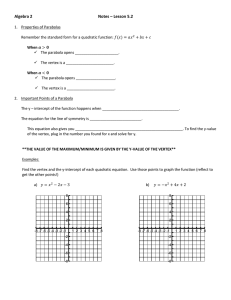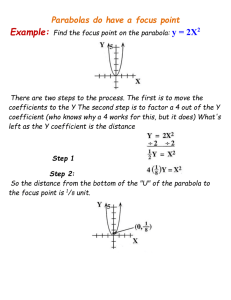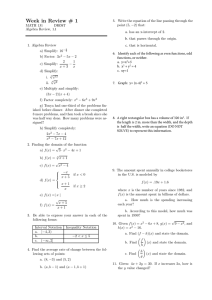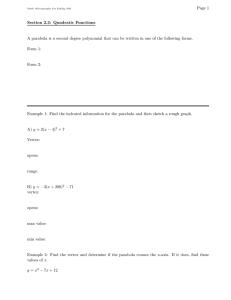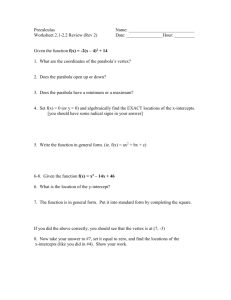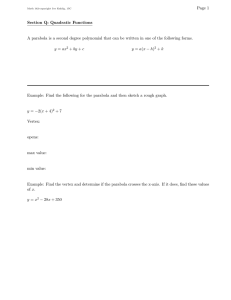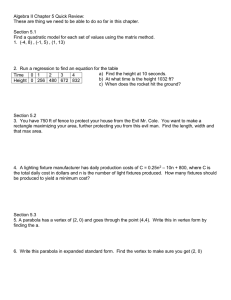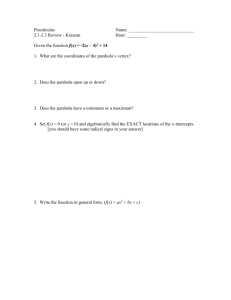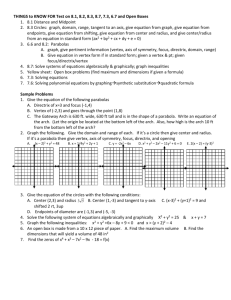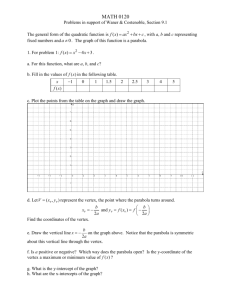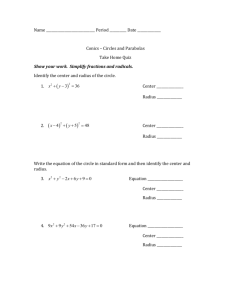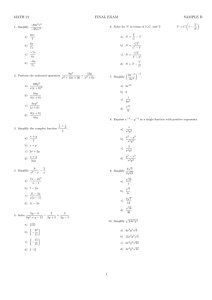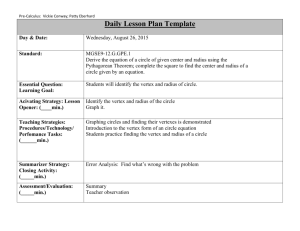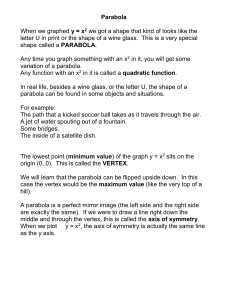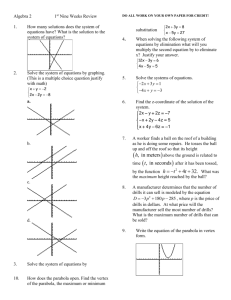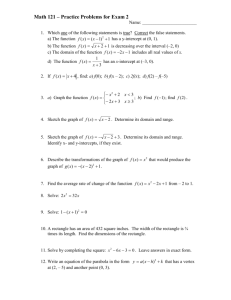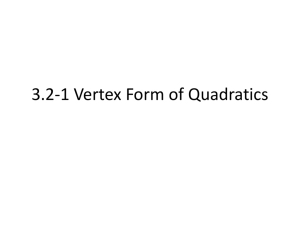Basic Algebra Sols
advertisement
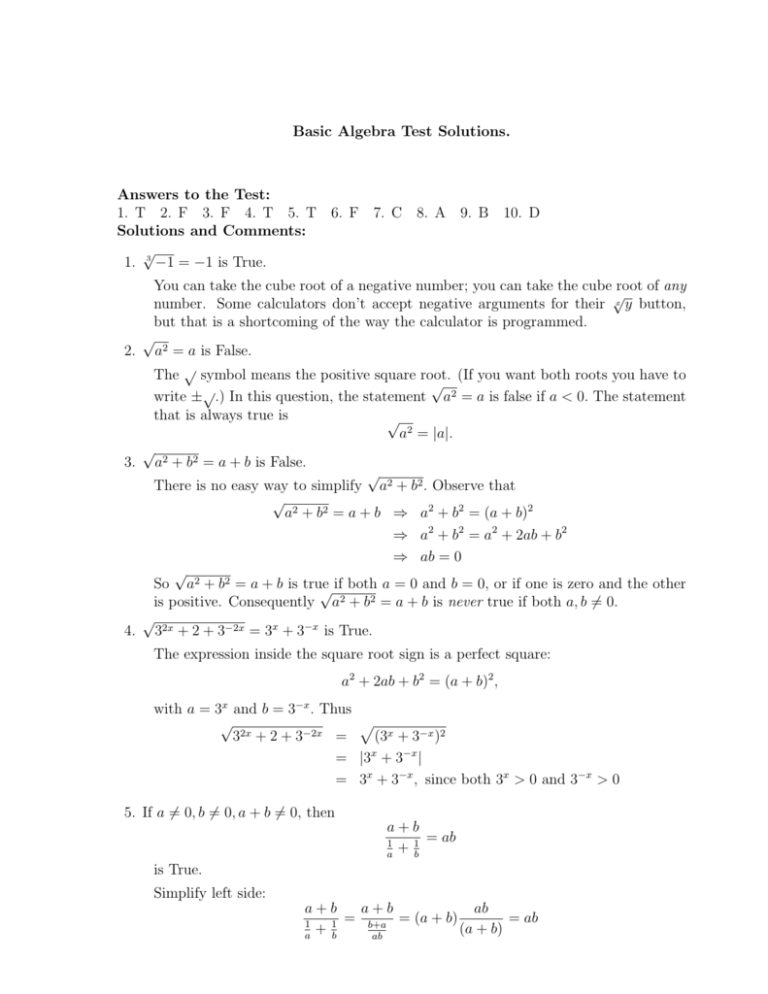
Basic Algebra Test Solutions. Answers to the Test: 1. T 2. F 3. F 4. T 5. T 6. F 7. C 8. A 9. B 10. D Solutions and Comments: √ 1. 3 −1 = −1 is True. You can take the cube root of a negative number; you can take the cube root of any √ number. Some calculators don’t accept negative arguments for their x y button, but that is a shortcoming of the way the calculator is programmed. √ 2. a2 = a is False. √ The symbol means the positive square root. (If you want both roots you have to √ √ write ± .) In this question, the statement a2 = a is false if a < 0. The statement that is always true is √ a2 = |a|. √ 3. a2 + b2 = a + b is False. √ There is no easy way to simplify a2 + b2 . Observe that √ a2 + b2 = a + b ⇒ a2 + b2 = (a + b)2 ⇒ a2 + b2 = a2 + 2ab + b2 ⇒ ab = 0 √ So a2 + b2 = a + b is true √ if both a = 0 and b = 0, or if one is zero and the other is positive. Consequently a2 + b2 = a + b is never true if both a, b 6= 0. √ 4. 32x + 2 + 3−2x = 3x + 3−x is True. The expression inside the square root sign is a perfect square: a2 + 2ab + b2 = (a + b)2 , with a = 3x and b = 3−x . Thus p √ 32x + 2 + 3−2x = (3x + 3−x )2 = |3x + 3−x | = 3x + 3−x , since both 3x > 0 and 3−x > 0 5. If a 6= 0, b 6= 0, a + b 6= 0, then a+b = ab 1 + 1b a is True. Simplify left side: a+b a+b ab = ab 1 1 = b+a = (a + b) (a + b) + a b ab 6. |x|3 = x3 is False. The statement is true if x ≥ 0, but not true if x < 0 : x < 0 ⇒ |x| = −x ⇒ |x|3 = (−x)3 = −x3 . 7. If x2 − x − 6 > 0, then x < −2 or x > 3. There are at least two ways to see this. Both require that you factor x2 − x − 6. Let y = x2 − x − 6 = (x − 3)(x + 2.) The graph of y is a parabola opening upwards with x intercepts x = −2 and x = 3. So the graph of y is above the xaxis if x < −2 or x > 3. Or you can solve the inequality by taking cases: x2 − x − 6 > 0 ⇔ (x − 3)(x + 2) > 0 ⇔ x − 3 > 0 and x + 2 > 0, or, x − 3 < 0 and x + 2 < 0 ⇔ x > 3 or x < −2 8. The vertex of the parabola with equation y = 5 + 6x − x2 is (x, y) = (3, 14). There are at least two ways to do this: one way using algebra, one way using calculus. You can complete the square: y = 5 + 6x − x2 = 14 − 9 + x − x2 = 14 − (9 − x + x2 ) = 14 − (x − 3)2 ; so the vertex is x = 3 and y = 14. Or you can find the vertex by setting y 0 = 0 : dy = 6 − 2x = 0 ⇔ x = 3. dx Then y = 5 + 18 − 9 = 14, as before. 9. The centre and radius of the circle with equation x2 + 2x + y 2 − 4y = 4 are centre: (x, y) = (−1, 2); radius: r = 3. This is an exercise in completing the square, both in the x variable, and in the y variable. x2 + 2x + y 2 − 4y = 4 ⇔ x2 + 2x + 1 + y 2 − 4y + 4 = 4 + 1 + 4 ⇔ (x + 1)2 + (y − 2)2 = 9 ⇔ (x + 1)2 + (y − 2)2 = 32 So the centre of the circle is (x, y) = (−1, 2) and its radius is r = 3. 10. If x < −1, then √ x2 + x + x = p −1 1 + 1/x + 1 . This is quite tricky. First of all, there are restrictions on x since x2 + x ≥ 0 ⇔ x(x + 1) ≥ 0 ⇔ x ≤ −1 or x ≥ 0. The expression simplifies differently in each case. If x > 0, then the answer is actually B. In either case, you start by rationalizing the numerator: ! √ 2+x−x √ √ x x2 + x + x = ( x2 + x + x) √ x2 + x − x x2 + x − x2 = √ x2 + x − x x = √ 2 x +x−x x = p 2 x (1 + 1/x) − x If x > 0, then p x2 (x + 1/x) = x p 1 + 1/x, and x x 1 p = p =p ; 2 x (1 + 1/x) − x x 1 + 1/x − x 1 + 1/x − 1 √ but if x < −1, then x2 = |x| = −x, so x p x2 (1 + 1/x) − x = x −x p 1 + 1/x − x = 1 −1 p =p . − 1 + 1/x − 1 1 + 1/x + 1
